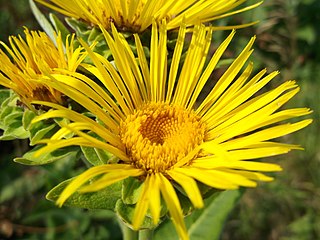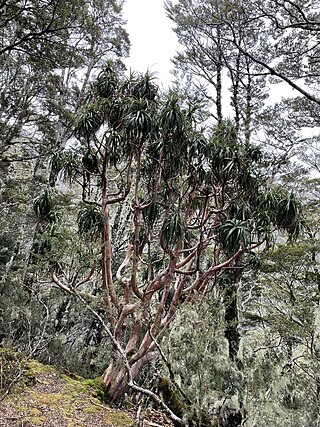
Germination is the process by which an organism grows from a seed or spore. The term is applied to the sprouting of a seedling from a seed of an angiosperm or gymnosperm, the growth of a sporeling from a spore, such as the spores of fungi, ferns, bacteria, and the growth of the pollen tube from the pollen grain of a seed plant.

Actaea racemosa, the black cohosh, black bugbane, black snakeroot, rattle-top, or fairy candle, is a species of flowering plant of the family Ranunculaceae. It is native to eastern North America from the extreme south of Ontario to central Georgia, and west to Missouri and Arkansas. It grows in a variety of woodland habitats, and is often found in small woodland openings.

Arctostaphylos uva-ursi is a plant species of the genus Arctostaphylos widely distributed across circumboreal regions of the subarctic Northern Hemisphere. Kinnikinnick is a common name in Canada and the United States. Growing up to 30 centimetres in height, the leaves are evergreen. The flowers are white to pink and the fruit is a red berry.

Inula is a genus of about 80 species of flowering plants in the family Asteraceae, native to Europe, Asia and Africa.

Cassytha is a genus of some two dozen species of obligately parasitic vines in the family Lauraceae. Superficially, and in some aspects of their ecology, they closely resemble plants in the unrelated genus Cuscuta, the dodders. When fruit and flowers are absent in the field, the physical resemblance is so close that few people without technical training can discern the difference. In this respect and in their ecology the two genera present a spectacular example of convergent evolution. Nonetheless, Nickrent comments that "Cassytha is uneqivocally assigned to Lauraceae based on (both) morphological and molecular data." In its divergence from habits typical of the Lauraceae, Cassytha also presents examples of mosaic evolution

Elecampane, pronounced and also called horse-heal or elfdock, is a widespread plant species in the sunflower family Asteraceae. It is native to Eurasia from Spain to Xinjiang province in western China, and naturalized in parts of North America.

The flora of India is one of the richest in the world due to the wide range of climate, topology and habitat in the country. There are estimated to be over 18,000 species of flowering plants in India, which constitute some 6-7 percent of the total plant species in the world. India is home to more than 50,000 species of plants, including a variety of endemics. The use of plants as a source of medicines has been an integral part of life in India from the earliest times. There are more than 3000 Indian plant species officially documented as possessing into eight main floristic regions : Western Himalayas, Eastern Himalayas, Assam, Indus plain, Ganges plain, the Deccan, Malabar and the Andaman Islands.
Seed dormancy is an evolutionary adaptation that prevents seeds from germinating during unsuitable ecological conditions that would typically lead to a low probability of seedling survival. Dormant seeds do not germinate in a specified period of time under a combination of environmental factors that are normally conducive to the germination of non-dormant seeds.

Nepenthes khasiana is an endangered tropical pitcher plant of the genus Nepenthes. It is the only Nepenthes species native to India. It is thought to attract prey by means of blue fluorescence.

Hodgsonia is a small genus of fruit-bearing vines in the family Cucurbitaceae.

Calendula officinalis, the pot marigold, common marigold, ruddles, Mary's gold or Scotch marigold, is a flowering plant in the daisy family, Asteraceae. It is probably native to southern Europe, but its long history of cultivation makes its precise origin unknown, and it is widely naturalised.

Muntingia is a genus of plants in the family Muntingiaceae, comprising only one species, Muntingia calabura, named in honour of Abraham Munting. It is native from Mexico south to Bolivia and Argentina. Its fruit is edible, and it has been widely introduced in other tropical areas.

Taraxacum officinale, the dandelion or commondandelion, is a herbaceous perennial flowering plant in the daisy family, Asteraceae. The common dandelion is well known for its yellow flower heads that turn into round balls of many silver-tufted fruits that disperse in the wind. These balls are called "clocks" in both British and American English. The name "blowball" is also used.

Anisodus tanguticus is a species of flowering plant belonging to tribe Hyoscyameae of subfamily Solanoideae of the nightshade family Solanaceae. It is thus closely related to Henbane and Deadly Nightshade. Solanaceae is a plant family which includes many important agricultural plants such as the potato and the tomato. It is mostly found growing in the Qinghai-Tibetan Plateau. A. tanguticus is collected and used mostly for its medicinal effects caused by the plant's biologically active nicotine and tropane alkaloids. It has a significant impact in China as one of the 50 fundamental herbs used in traditional Chinese medicine.

Sambucus racemosa is a species of elderberry known by the common names red elderberry and red-berried elder.

Phacelia tanacetifolia is a species of flowering plant in the borage family Boraginaceae, known by the common names lacy phacelia, tansy-leaf phacelia, blue tansy, purple tansy or fiddleneck (UK).

Angelica acutiloba is a perennial herb from the family Apiaceae or Umbelliferous. It is predominately in Japan and perhaps endemic (unique). It is now distributed widely and cultivated in Jilin, China, Korea, Taiwan and Indonesia.

Orobanche hederae, the ivy broomrape, is, like other members of the genus Orobanche, a parasitic plant without chlorophyll, and thus totally dependent on its host, which is ivy. It grows to 60 cm (2 ft), with stems in shades of brown and purple, sometimes yellow. The flowers are 10–22 mm (0.4–0.9 in) long, cream in colour with reddish-purple veins.

Dracophyllum traversii, commonly known as mountain neinei, grass tree, and pineapple tree is a species of flowering plant in the heath family Ericaceae. It is a deciduous tree endemic to New Zealand. It reaches a height of 0.2–13 m (0.66–42.65 ft) and has leaves which form tufts at the end of its branches. It has a lifespan of between 500 and 600 years.

Photoblasticism is a mechanism of seed dormancy. Photoblastic seeds require light in order to germinate. Once germination starts, the stored nutrients that have accumulated during maturation start to be digested which then supports cell expansion and overall growth. Within light-stimulated germination, Phytochrome B (PHYB) is the photoreceptor that is responsible for the beginning stages of germination. When red light is present, PHYB is converted to its active form and moves from the cytoplasm to the nucleus where it upregulates the degradation of PIF1. PIF1, phytochrome-interaction-factor-1, negatively regulates germination by increasing the expression of proteins that repress the synthesis of gibberellin (GA), a major hormone in the germination process. Another factor that promotes germination is HFR1 which accumulates in light in some way and forms inactive heterodimers with PIF1.



















